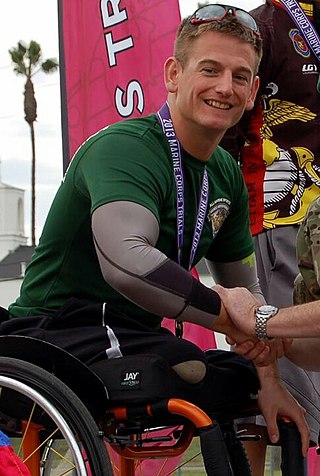Related Research Articles

The Paralympic sports comprise all the sports contested in the Summer and Winter Paralympic Games. As of 2020, the Summer Paralympics included 22 sports and 539 medal events, and the Winter Paralympics include 5 sports and disciplines and about 80 events. The number and kinds of events may change from one Paralympic Games to another.

Melissa Stockwell is an American two-time Paralympic triathlete, swimmer and former U.S. Army officer. Competing in the 2008 Summer Paralympics in three swimming events, she returned to race in the 2016 Paralympic Games and won a bronze medal in the inaugural triathlon event on September 11, 2016.

The Summer Paralympics, also known as the Games of the Paralympiad, are an international multi-sport event where athletes with physical disabilities compete. This includes athletes with mobility disabilities, amputations, blindness, and cerebral palsy. The Paralympic Games are held every four years, organized by the International Paralympic Committee. Medals are awarded in every event, with gold medals for first place, silver for second and bronze for third, a tradition that the Olympic Games started in 1904.

Claire McLean is an Australian Paralympic cyclist and paratriathlete. She represented Australia at the 2016 Rio Paralympics when paratriathlon made its debut at the Paralympics.
T38 and CP8 are disability sport classification for disability athletics intended for people with cerebral palsy. It includes people who have coordination impairments such as hypertonia, ataxia and athetosis. Runners in this class may appear to have a slight limp when they are running but otherwise have a stride similar to able-bodied runners. Events for this class include 100 meters, 400 meters, 1,500 meters, and the long jump.
T43 is a disability sport classification for disability athletics, applying to athletes with "Double below knee amputation or similar disability." It includes ISOD classified athletes from the A4 and A9 classes.
Para triathlon is a variant of the triathlon for athletes with a physical disability. The sport is governed by World Triathlon, and was first held as a Paralympic event at the 2016 Summer Paralympics in Rio de Janeiro, Brazil.
H3 is a para-cycling classification. The UCI recommends this be coded as MH3 or WH3.
H2 is a para-cycling classification. The Union Cycliste Internationale recommends this be coded as MH2 or WH2.
H4 is a para-cycling classification. The UCI recommends this be coded as MH4 or WH4.
Para-cycling classification is the process of classifying participants in para-cycling covering four functional disability types. The classification system includes classes for handcycles for people who have lower limb mobility issues. The sport is governed by the Union Cycliste Internationale (UCI).
Sally Pilbeam (1978) is an arm amputee Australian paratriathlete. In 2014, she won a gold medal at the 2014 World Triathlon Series Final in Edmonton, Alberta, Canada.

Kathleen Margaret "Katie" Kelly is an Australian paratriathlete, who has a degenerative disease known as Usher syndrome. Kelly began competing in the PT5 paratriathlon classification in February 2015 when her condition deteriorated to a legally blind state. She has just 30 per cent of her vision. With her guide Michellie Jones, Kelly won gold medals at the 2015 and 2017 ITU World Championships and 2016 Rio Paralympics. She competed at the 2020 Summer Paralympics.

The paratriathlon competitions at the 2016 Summer Paralympics in Rio de Janeiro took place from 10–12 September 2016 at Fort Copacabana. Sixty athletes competed across two genders, and six events. This was the first Paralympic Games to feature paratriathlon, one of two new sports added to the schedule for 2016.

Brant Garvey is an Australian leg amputee paratriathlete. He represented Australia at the 2016 Rio Paralympics when paratriathlon made its debut at the Paralympics.
H5 is a para-cycling classification. The UCI recommends this be coded as MH5 or WH5.

Emily Tapp is an Australian wheelchair Paralympic athlete and triathlete. She was selected to represent Australia at the 2016 Rio Paralympics in athletics but was forced to withdraw before the Games due to a burns injury. She represented Australia at the 2020 Summer Paralympics in paratriathlon.

Nic Beveridge is an elite Australian triathlete with a disability. He represented Australia at the 2016 Rio Paralympics when Triathlon made its debut at the Games and 2020 Tokyo Paralympics. He represented Australia at the 2018 Gold Coast Commonwealth Games where he won a silver medal.

Melissa Reid is a visually impaired British paratriathlete who competes in the PTVI classification. She is a Paralympic bronze medallist and a former World and European Champion. She is based in Falmouth in Cornwall.

Joseph Townsend is a British paratriathlete who competes in the PTWC classification. Townsend has won European and world medals as well as becoming Commonwealth Champion in 2018. He represented Great Britain at the 2016 Paralympic Games in Rio, where he finished sixth. Townsend has won the GBR Paratriathlon National Championships for four consecutive years- 2016, 2017, 2018, 2019. He lost both legs whilst serving in Afghanistan, after stepping on an IED in 2008. Joe Townsend is based in Eastbourne, England, where he was born.
References
- ↑ "Paratriathlon Categories". Triathlon.org. Retrieved 2020-06-21.
- ↑ "Paralympic Classification". paralympic.org. Retrieved 2020-06-21.
- ↑ "Para Triathlon Classification & Categories". International Paralympic Committee. Retrieved 2021-10-22.
- ↑ "Tokyo 2020 Paratriathlon Classifications Explained". www.britishtriathlon.org. Retrieved 2021-10-22.
- 1 2 Triathlon, World (2020-01-01). "Paratriathlon - what you need to know ahead of Tokyo". World Triathlon. Retrieved 2021-10-22.
- 1 2 "ITU Paratriathlon Classification Rules and Regulations" (PDF). World Triathlon. August 2013. p. 25. Retrieved August 22, 2023.
- ↑ "World Triathlon Paratriathlon Classification Research Group meets in San Diego" . Retrieved 16 Jan 2013.
- ↑ "Classification History". Bonn, Germany: International Paralympic Committee. Retrieved 30 July 2012.
- ↑ "Paratriathlon Categories". Triathlon.org. Retrieved 2016-08-20.
- ↑ "What is Classification?". Sydney, Australia: Australian Paralympic Committee. Retrieved 30 July 2012.
- ↑ ""/> <meta property="og:type" content="". www.ironman.com. Archived from the original on 28 October 2012. Retrieved 17 January 2022.
- 1 2 "Rio 2016 Classification Guide" (PDF). International Paralympic Committee. International Paralympic Committee. March 2016. Retrieved July 22, 2016.